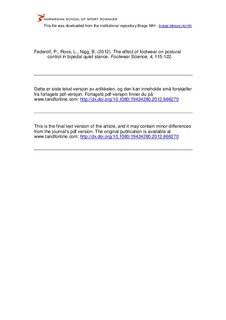| dc.contributor.author | Federolf, Peter | |
| dc.contributor.author | Roos, Lilian | |
| dc.contributor.author | Nigg, Benno | |
| dc.date.accessioned | 2014-01-14T11:31:53Z | |
| dc.date.available | 2014-01-14T11:31:53Z | |
| dc.date.issued | 2012 | |
| dc.identifier | Seksjon for fysisk prestasjonsevne / Department of Physical Performance | |
| dc.identifier.citation | Footwear Science. 2012, 4, 115-122 | no_NO |
| dc.identifier.uri | http://hdl.handle.net/11250/171182 | |
| dc.description | I Brage finner du siste tekst-versjon av artikkelen, og den kan inneholde ubetydelige forskjeller fra forlagets pdf-versjon. Forlagets pdf-versjon finner du på www.tandfonline.com: http://dx.doi.org/10.1080/19424280.2012.666270 / In Brage you'll find the final text version of the article, and it may contain insignificant differences from the journal's pdf version. The original publication is available at www.tandfonline.com: http://dx.doi.org/10.1080/19424280.2012.666270 | no_NO |
| dc.description.abstract | Assessments of the occurrence of falls in elderly populations reported an increased risk when barefoot as compared to shod conditions, suggesting that footwear has an effect on the postural control system. However, the results of studies analysing static stability in laboratory tests by evaluating the centre of pressure (COP) excursion are inconsistent. The purpose of this study was therefore to investigate the effects of footwear on the postural control system by quantitatively assessing the postural movements executed during quiet stance. The postural movements of 29 subjects were recorded using a standard marker-based motion analysis system. Three footwear conditions were tested: barefoot, a casual athletic shoe and so-called unstable shoes. One-dimensional (1D) principal movement (PM) components were determined by performing a principal component analysis (PCA) on the posture vectors consisting of the 3D coordinates of all markers. The relative contribution of the first five PMs to the entire postural movement, their range of motion and their persistence (detrended fluctuation analysis, DFA) were determined. Repeated-measures analyses of variance (ANOVAs) revealed significant differences between all three shoe conditions. Specifically, when standing in unstable as compared to the normal shoes it was found that higher-order principal components contributed less to the entire movement, that the range of motion in all five PMs was substantially increased, and that the persistence was higher in the first two PMs. When comparing barefoot to normal shoes, it was found that in barefoot standing higher-order principal components contributed less to the entire movement and the persistence was increased in the first and decreased in the third principal component. These results demonstrate that a direct analysis of postural movements reveals additional information about the effect of footwear that is not available from COP measurements. | no_NO |
| dc.language.iso | eng | no_NO |
| dc.publisher | Taylor and Francis | no_NO |
| dc.subject | stability | no_NO |
| dc.subject | static balance | no_NO |
| dc.subject | principal component analysis (PCA) | no_NO |
| dc.subject | coordination of movements | no_NO |
| dc.subject | postural control strategy | no_NO |
| dc.title | The effect of footwear on postural control in bipedal quiet stance | no_NO |
| dc.type | Journal article | no_NO |
| dc.type | Peer reviewed | no_NO |
| dc.subject.nsi | VDP::Humanities: 000::Architecture and design: 140::Theory of architecture and design: 142 | no_NO |
| dc.subject.nsi | VDP::Technology: 500 | no_NO |
| dc.subject.nsi | VDP::Technology: 500::Materials science and engineering: 520::Other material science: 529 | no_NO |
| dc.subject.nsi | VDP::Medical disciplines: 700::Health sciences: 800::Other health science disciplines: 829 | no_NO |
| dc.source.journal | Footwear Science | no_NO |
| dc.identifier.doi | 10.1080/19424280.2012.666270 | |
